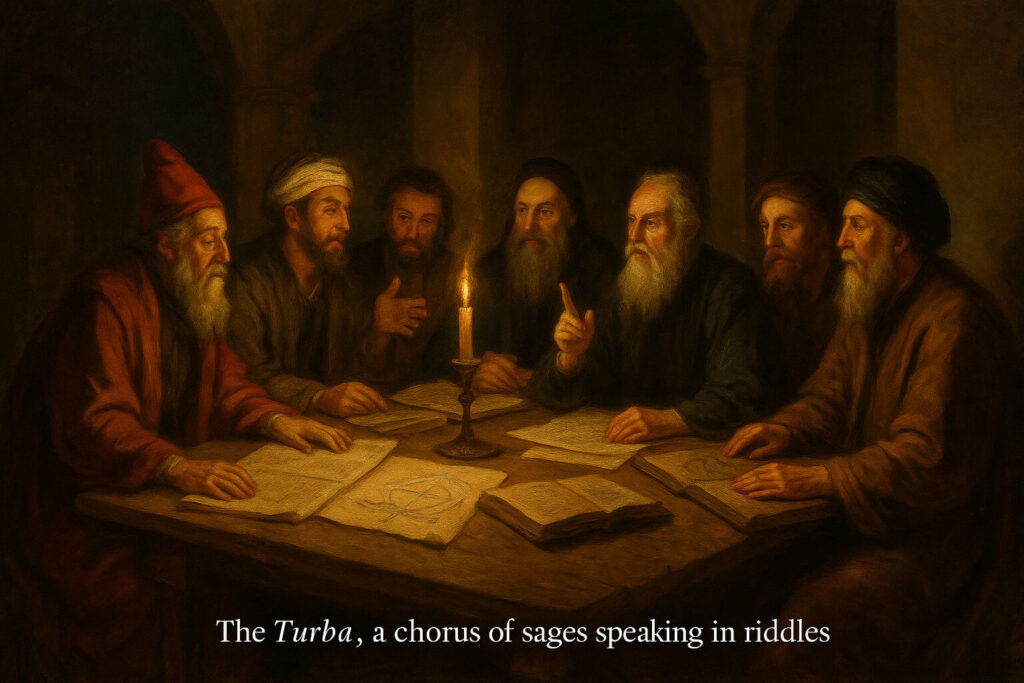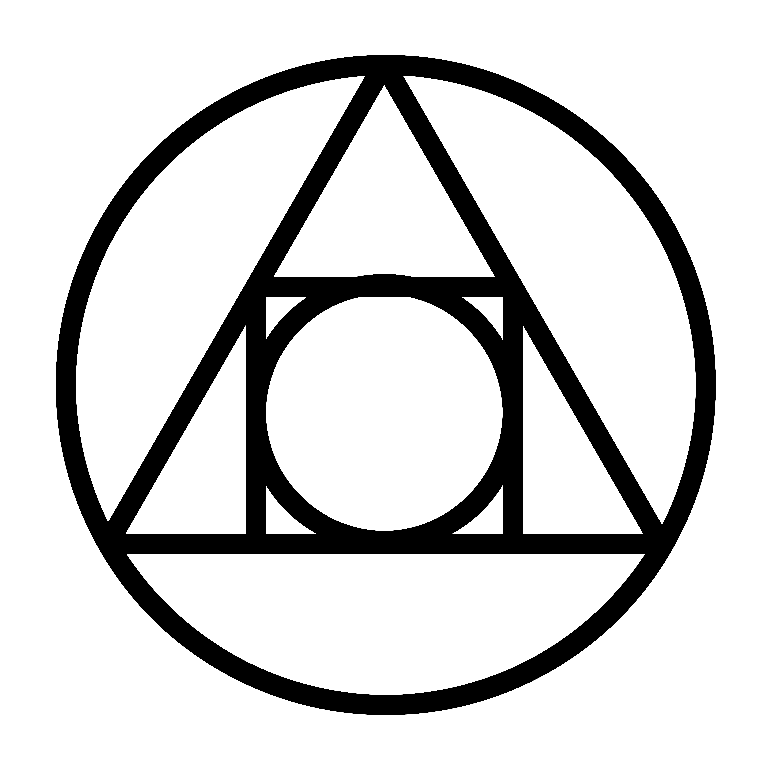Philosopher’s Stone Part Two: Turba Philosophorum (12th Century) — The Doctrine of Permanent Water

Philosopher’s Stone Part Two: Turba Philosophorum (12th Century) — The Doctrine of Permanent Water
Bibliographic Introduction
The Turba Philosophorum, or “Assembly of the Philosophers,” is among the oldest Latin alchemical texts, likely translated from Arabic sources in the twelfth century. Unlike the concise Emerald Tablet or the single-voiced Secret Book of Artephius, the Turba is structured as a dialogue among sages—Pythagoras, Anaxagoras, Democritus, and others—each contributing dicta on the elements, the work of transmutation, and the nature of the Stone.
Though it reads like a Platonic symposium, the Turba is an alchemical catechism. It blends cosmology with craft, offering both metaphysical reflections on the four elements and veiled instructions on operations. Its transmission in Latin manuscripts influenced the scholastic milieu in which Pseudo-Geber later systematized alchemy.
Philosophical Mercury in the Turba
The Turba repeatedly invokes a mysterious “permanent water” (aqua permanens), a solvent that dissolves bodies, whitens them, and brings them to perfection .
-
This water is equated with vinegar, gum, spume of Luna, and White Magnesia.
-
It is said to be “stronger than gold” and yet perfected only through contact with gold .
-
It is also called “the venom of the wise,” capable of turning bodies into spirit and spirit into body.
In short, the Turba’s philosophical mercury is this permanent water: volatile yet fixed, corrosive yet nourishing, the mediating agent that unites body and spirit. Where Artephius identified mercury within antimony, the Turba points instead to a universal solvent hidden in metals, salts, and vinegars.
Extracting the Method
From the sprawling dicta, we can reconstruct a set of operations:
-
Subject: “Our copper” is often named as the body to be transformed. Lead, tin, and orpiment also appear as adjuncts.
-
Permanent Water: Prepared through sharp vinegar, gum, or spume of Luna, this water is indispensable.
-
Union: The body (copper, lead, etc.) is dissolved in permanent water, reduced to blackness, then whitened.
-
Vessel: A sealed glass vessel is implied, to prevent the spirit from escaping.
-
Fire: Gentle, continuous heat, sometimes varied in stages (forty days of putrefaction, followed by repeated imbibitions).
-
Stages: Blackening, whitening, reddening, culminating in a “Tyrian purple” stone.
-
Product: A stone “not a stone,” capable of tincting metals with an invariable color.
One dictum declares bluntly: “No true tincture is made except from our copper” . Another insists: “Unless you understand permanent water, nothing will be effected” . These are strong methodological markers.
Evidence of Practice
Compared to the Emerald Tablet’s allegory, the Turba shows clear signs of laboratory familiarity. The authors describe putrefaction lasting forty days, washing with sea water and vinegar, pounding calxes, and observing color shifts. Such details indicate practical bench knowledge.
Yet the dialogic form also multiplies metaphors: egg, magnet, seed, matrix. The same “permanent water” is called vinegar, spume, gum, and lead’s companion. This confusion likely reflects multiple traditions woven together rather than a single adept’s testimony.
Thus, the Turba reads as a compilation of practitioners’ lore, not the voice of one experimenter.
Contribution to the Stone Tradition
The Turba makes three enduring contributions:
-
Permanent Water: It establishes aqua permanens as the indispensable medium of the work, the clear ancestor of later “philosophical mercury.”
-
Copper Doctrine: It insists that copper, ruled and whitened, is the starting body. This connects the Stone to the transformation of base metals.
-
Process Outline: Putrefaction → whitening → reddening → Tyrian purple. This becomes the canonical color sequence.
Placed between Zosimos and Artephius, the Turba is the bridge: from Hellenistic circulation of vapors to the Latin doctrine of a fixed water.
Deciphered Method
If we strip away the allegory, the Turba’s method is:
-
Take copper (sometimes with lead or tin).
-
Dissolve it in permanent water (vinegar/gum/spume).
-
Seal in a vessel; putrefy for forty days.
-
Whiten by repeated washing and imbibition.
-
Coagulate until red or purple.
Here, philosophical mercury is not metallic quicksilver but the permanent water that dissolves and reconstitutes bodies. This points to acidic solvents—vinegar, vitriolic waters, metallic salts—transposed into allegory.
Conclusion
The Turba Philosophorum is the first Latin assembly where philosophers speak in chorus of the Stone. Its central doctrine is that permanent water is the philosophical mercury: the agent that dissolves, whitens, and fixes. The text does not name antimony or purified quicksilver; those emphases come later. Instead, it proclaims: without this water, nothing is achieved.
Whether the compilers themselves possessed the Stone is doubtful. But they preserved the doctrine that would animate later adepts: one subject, one water, one vessel, one fire, one sequence of colors.
| Author / Text | Philosophical Mercury | Preparation Steps | Union Method | Fire / Heat | Color Signs | Product Claims |
|---|---|---|---|---|---|---|
| Zosimos of Panopolis (c. 300 CE) | “Divine water” in the kerotakis; volatile spirit ascending and descending | Calcination, sublimation, distillation, washing | Circulation in sealed vessel; dissolution and recombination | Gentle, regulated heating; moist fire | Blackening, whitening, reddening | Tincture, purification of metals; spiritual rebirth |
| Emerald Tablet (Arabic/Latin, 9th–12th c.) | “One Thing” mediating heaven and earth; volatile principle implied | None explicit; “separate the subtle from the gross” | Circulation: ascent and descent of the subtle | Not named; implied gentle force | None specified; allegorical “glory of the whole” | Perfection of all things; universal power |
| Turba Philosophorum (12th c., Arabic → Latin) | Permanent water: vinegar/gum/spume of Luna; volatile-fixative solvent | Putrefaction 40 days; washing; imbibition; coagulation | Copper (sometimes with lead/tin) dissolved in permanent water | Gentle fire; sealed vessel; staged regimen | Blackening → Whitening → Reddening → Tyrian purple | Tincture of metals; Stone “not a stone”; invariable color |
